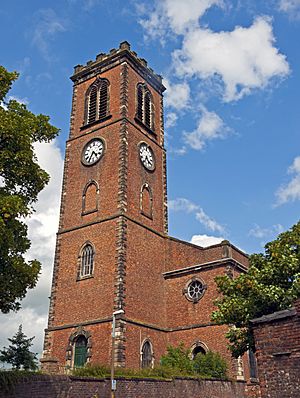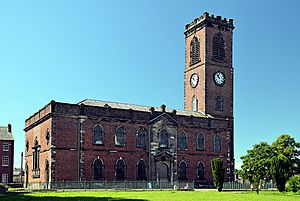Christ Church, Macclesfield facts for kids
Quick facts for kids Christ Church, Macclesfield |
|
|---|---|

Church from the southwest, 2014
|
|
| Lua error in Module:Location_map at line 420: attempt to index field 'wikibase' (a nil value). | |
| OS grid reference | SJ 914 735 |
| Location | Great King Street, Macclesfield, Cheshire |
| Country | England |
| Denomination | Anglican |
| Website | Churches Conservation Trust |
| Architecture | |
| Functional status | Redundant |
| Heritage designation | Grade II* |
| Designated | 14 April 1949 |
| Architectural type | Church |
| Style | Georgian |
| Completed | 1777 |
| Specifications | |
| Capacity | 1,800 |
| Materials | Brick with stone dressings Slate roof |
Christ Church is an old Anglican church located on Great King Street in Macclesfield, Cheshire, England. It is no longer used for regular church services, but it is still a special place. The church is listed as a Grade II* building, which means it is very important and protected. The Churches Conservation Trust takes care of it. You can visit the church at certain times. It was used as a church until 1981 and is sometimes still used for special events.
Contents
History of Christ Church
In the late 1700s, the main church in Macclesfield, St Michael's, was too small for all the people living in the town. A local industrialist named Charles Roe wanted to build a new church. He built Christ Church for a priest named David Simpson, who became its first vicar.
The main part of the church was built very quickly in 1775, taking only seven months. It opened on Christmas Day that year. The tall tower was added the next year. It stands about 32.6 meters (107 feet) high. This height was chosen to be as tall as the tower of St Michael's Church. David Simpson was a good friend of John Wesley, who started the Methodist movement. It was unusual for an Anglican church, but Simpson invited Wesley to preach at Christ Church many times. In 1985, the church was officially given to the Churches Conservation Trust to look after.
A local group called The Roe-naissance Project started in 2012. They are working with the Churches Conservation Trust to find new ways to use the building.
Church Design and Features
Outside the Church
Christ Church is built from brick with stone details. It is designed in the Georgian style, which was popular in the 1700s. The church has a tower at the west end, a main hall called a nave, and a smaller area at the east end called a chancel.
The tower has doors on the west and north sides. Above the west door, there is a window with a rounded top. Higher up, there are windows, some of which are just for decoration, and clock faces. The top of the tower has a decorative wall with a pattern, like a castle. The outside walls of the nave and chancel look like they have two levels. At the east end, there is a large window with round windows and doors on each side. In the middle of the north side, there is a door with a triangular shape above it. The very top edges of the tower and the church used to have tall, pointed decorations called pinnacles, but these are no longer there.
Inside the Church
Inside Christ Church, there is a continuous balcony that goes around the north, west, and south sides. This balcony is held up by columns made of cast iron, which are covered in wood. Using cast iron like this was very new for churches at the time. The church organ is located in the west balcony. The ceiling is curved and has simple plaster panels.
The church has special box pews, which are like small enclosed seating areas. There is also a small marble baptismal font for baptisms. The beautiful stained glass in the east window was made by William Wailes. Another window on the south side has stained glass by Morris & Co..
On the south wall, there is a monument to Charles Roe, made from black and white marble in 1784 by John Bacon. It shows a sculpture of Roe's head, along with pictures of the church, Roe's silk factory, and his copper works. There is also a monument to David Simpson on the south wall.
The organ has three keyboards and was built in 1875 by Gray & Davison. The church has a set of ten bells that are still used regularly. The bells were first made in 1777. Over the years, some bells were replaced or added. Today, bell ringers practice regularly on Monday evenings.
The original three-level pulpit and choir stalls have been taken down and stored. The church also has some beautiful carvings from a group known as the "Macclesfield School of Carving." The most important carving is a detailed altar screen from the Edwardian period. This screen was taken apart during a restoration project to make the church look more like it did in Georgian times.
More to Explore
- Grade II* listed buildings in Cheshire East
- List of churches preserved by the Churches Conservation Trust in Northern England
- Listed buildings in Macclesfield


